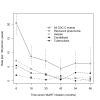Incidence and determinants of new AIDS-defining illnesses after HAART initiation in a Senegalese cohort
- PMID: 20565900
- PMCID: PMC2905421
- DOI: 10.1186/1471-2334-10-179
Incidence and determinants of new AIDS-defining illnesses after HAART initiation in a Senegalese cohort
Abstract
Background: Although a dramatic decrease in AIDS progression has been observed after Highly Active Anti Retroviral Therapy (HAART) in both low- and high-resource settings, few data support that fact in low-resource settings.This study describes the incidence of AIDS-defining illnesses (ADI) after HAART initiation and analyzes their risk factors in a low-resource setting. A focus was put on CD4 cell counts and viral load measurements.
Methods: 404 HIV-1-infected Senegalese adult patients were enrolled in a prospective observational cohort and data censored as of April 2008. A Poisson regression was used to model the incidence of ADIs over two periods and to assess its association with baseline variables, current CD4, current viral load, CD4 response, and virological response.
Results: ADI incidence declined from 20.5 ADIs per 100 person-years, 95% CI = [16.3;25.8] during the first year to 4.3, 95% CI = [2.3;8.1] during the fourth year but increased afterwards. Before 42 months, the decrease was greater in patients with clinical stage CDC-C at baseline and with a viral load remaining below 1000 cp/mL but was uniform across CD4 strata (p = 0.1). After 42 months, 293 patients were still at risk. The current CD4 and viral load were associated with ADI incidence (decrease of 21% per 50 CD4/mm3 and of 61% for patients with a viral load < 1000 cp/mL).
Conclusions: During the first four years, a uniform decline of ADI incidence was observed even in patients with low CD4-cell counts at HAART initiation as long as the viral load remained undetectable. An increase was noted later in patients with immunologic and virological failures but also in patients with only virological failure.
Figures


References
-
- Mocroft A, Sabin C, Youle M. Changes in AIDS-Defining Illnesses in a London Clinic, 1987-1998. JAIDS. 1999;21:401–407. - PubMed
-
- Ives NJ, Gazzard BG, Easterbrook PJ. The changing pattern of AIDS-defining illnesses with the introduction of highly active antiretroviral therapy (HAART)in a London clinic. J Infect. 2001;42(2):134–139. - PubMed
-
- Palella FJ, Delaney K, Moorman A, Loveless M, Fuhrer J, Satten G, Aschman D, Holmberg SD. Declining morbidity and mortality among patients with advanced human immunodeficiency virus infection. N Engl J Med. 1998;338:853–860. - PubMed
-
- Bonnet F, Chene G, Thiebaut R, Dupon M, Lawson-Ayayi S, Pellegrin JL, Dabis F, Morlat P. Trends and determinants of severe morbidity in HIV-infected patients: the ANRS CO3 Aquitaine Cohort, 2000-2004. HIV Med. 2007;8(8):547–554. - PubMed
-
- Ledergerber B, Egger M, Erard V, Weber R, Hirschel B, Furrer H, Battegay M, Vernazza P, Bernasconi E, Opravil M. AIDS-related opportunistic illnesses occurring after initiation of potent antiretroviral therapy: the Swiss HIV Cohort Study. Jama. 1999;282(23):2220–2226. - PubMed
Publication types
MeSH terms
Substances
LinkOut - more resources
Full Text Sources
Medical
Research Materials
Miscellaneous

